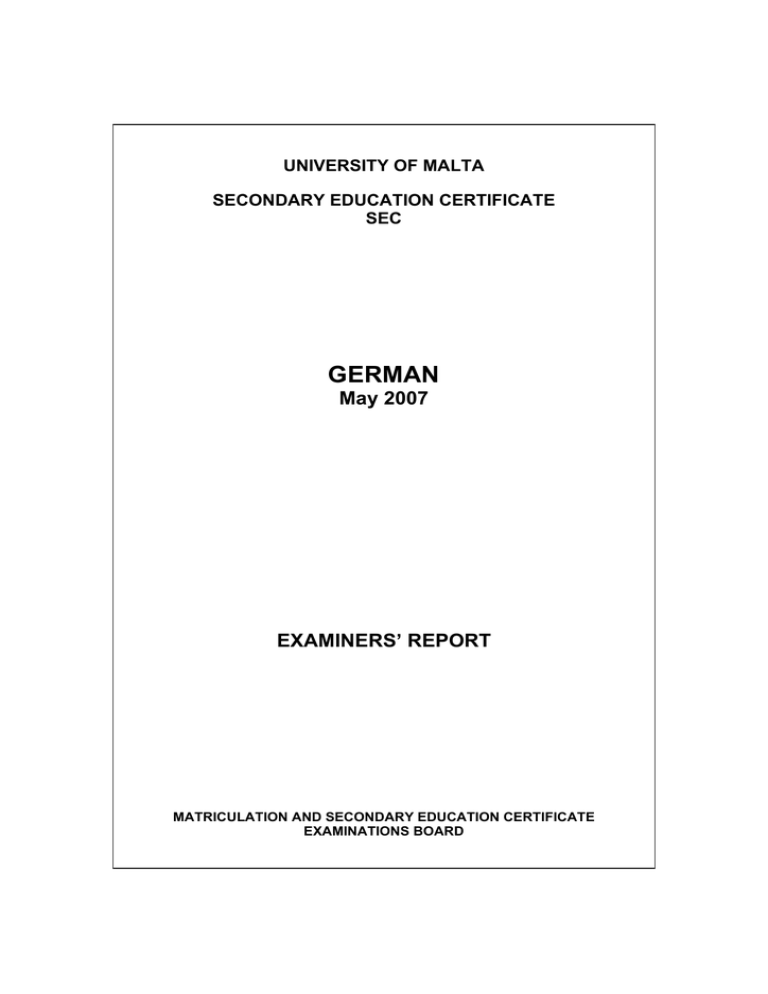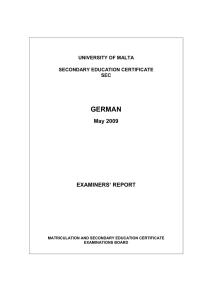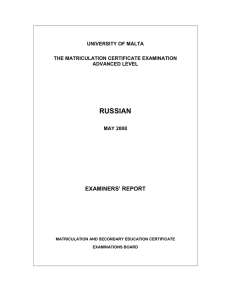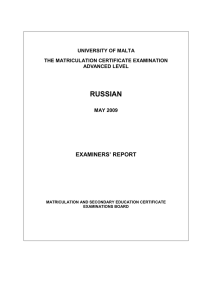GERMAN May 2007 EXAMINERS’ REPORT
advertisement

UNIVERSITY OF MALTA SECONDARY EDUCATION CERTIFICATE SEC GERMAN May 2007 EXAMINERS’ REPORT MATRICULATION AND SECONDARY EDUCATION CERTIFICATE EXAMINATIONS BOARD SEC Examiners’ Report – May 2007 SEC GERMAN MAY 2007 SESSION EXAMINERS’ REPORT 466 candidates sat for the SEC Level examination in German in May 2007. (446 in 2006; 485 in 2005; 423 in 2004). 306 (66%) students sat for Paper IIA while 160 (34%) opted for Paper IIB. The table below shows the distribution of grades obtained for the May 2007 session. Table 1. Distribution of Grades Grade 1 2 3 4 5 6 7 U Absent Total I & IIA 18 25 53 70 42 - - 92 6 306 I & IIB - - - 15 29 26 17 63 10 160 TOTAL % of Total 18 25 53 85 71 26 17 155 16 466 3.86% 5.36% 11.37% 18.24% 15.24% 5.58% 3.65% 33.26% 3.43% 100 A marking scheme was used. For Section B and C (the Essay part) of paper II (i.e. for the Letter and the Picture Composition) of both options, two markers gave their mark separately and the final mark was calculated on both marks. Where large discrepancies were noticed, the mark was discussed again by all markers on the panel. There were three markers and each marker assessed scripts from both options (i.e. A and B papers). Paper 1 Paper 1: Listening Comprehension In general most of the students answered the short texts well. Some got them all right, whilst others got one or more answers wrong. But on the whole, students performed well. Regarding the longer texts (particularly Part 2A) one can notice that most candidates did not spell correctly when writing their answers. Among the most common orthographical mistakes were lacking capital letters at the beginning of Nouns and wrong spelling of common German nouns (example the word ‘Feld’ was written in several versions including ‘Fehlt’, ‘Felt’ and ‘Welt’). Paper 1: Written Usage In the initial multiple choice exercise tackling various aspects of grammar taught during the course, students – particularly those sitting for Paper IIA – performed quite well. However, very striking was a general lack of knowledge of verbs in the past tense (example: ‘Nachmittags kam instead of kamen dann noch einige gute Freunde aus der Nachbarschaft zu mir’). The mistake quoted and various other similar mistakes show that a number of students 2 SEC Examiners’ Report – May 2007 knew the verbs but made serious mistakes when asked to do their conjugations. Other common mistakes observed in this part included misuse of adjective endings and their application, as well as the incorrect use of conjunctions. Paper 2 Section A Section A (adverts and texts – answers in English) carries 50% of the marks of Paper II and examines the students’ ability to understand and react correctly to different texts in German, hence testing the candidates’ passive knowledge of the language. Some questions in paper A (Question 7, 12 and 18) were answered correctly by all students. Moreover, some other questions including the first two, were among the most challenging. Furthermore, most students taking option A failed to give a complete answer for question 20 where the majority answered ‘to ask doctor or chemist’ but not ‘to read the instructions’. Many students translated ‘Freude’ (question 5) as friends. As noted in previous years, this might point to the candidates’ lack of knowledge transfer in the foreign language. Students seem to be unable to extract the meaning of a word from a sentence. In the reading comprehension many students seemed to be confused when reading long words in German (example ‘Verkehrsteilnehmer’). Teachers of German should encourage students to realize that very often splitting up these compound words into smaller nouns, will eventually ease the understanding of what seems to be impossible to comprehend. The general vocabulary level of Candidates opting paper 2 B was poor. Some even found easy questions such as question 2 requiring the translation of ‘mehr drin’ challenging. Some other very common words which were translated incorrectly include: Gymnasium in question 24 (which students translated as to do gymnastics) Straβenbahn in question 26 (which students translated as street train Bein in question 27 (which students translated as bone), Paper 2 Essays Paper 2 A students Letter writing (Section B): The candidates were able to write average to good standard letters in this section. This year, the usual lack of proper grammar, sentence structure and word order problems were encountered. Furthermore, it was obvious that some students learned the introduction to the letter and some expressions by heart. They knew those well and in the rest they made several serious mistakes. This year, the usual lack of proper grammar, sentence structure and word order problems were encountered. The last section of the letter (i.e. discussing environmental contribution) was completely disregarded by some students. Picture composition (Section C): Some students did try to write decent, flowing and sensible stories. However, on the whole, performance varied a lot in this section. In many cases, basic lack of knowledge of vocabulary was evident. Among the most common mistakes were Biljetten (instead of Fahrkarten in Picture 1), geforgotten (instead of ‘vergessen’ in Picture 2) and geringt (instead of ‘angerufen’ in Picture 3). Evidently, a number of candidates even confused languages including French, Italian, Maltese and English in what they wrote. A particular case was that of a student who wrote the whole essay in good Italian. 3 SEC Examiners’ Report – May 2007 Similarly students often had difficulties with proper use of the Perfect of Präteritum, word order and sentence structure. Remarkable was the difficulty of some candidates who had problems with using the correct personal pronouns (example not able to distinguish between ‘sein’ and ‘ihr’). Paper 2 B students Letter writing (Section B): The same comments stated for paper A candidates apply to these students opting paper 2B. In this case, having learnt the date by heart, some students sitting for option B even changed the month from ‘Mai’ to ‘März’ or even ‘Januar’, instead of writing ‘den 13. Mai’ the real date of the exam. Picture composition (Section C): Even though a handful of students wrote well written stories which were a pleasure to read, most candidates found this part amazingly difficult to write about. Some students in fact did not even answer this section. Again basic grammar and vocabulary problems were noticed. Remarkable is the fact that many students did not even know the word equivalent for lion (the animal featuring in the picture composition). Instead mistakenly, many ended up using the word for gorilla, giraffe or bear. Conclusion The analysis and comments above, seem to be highlighting a problem which from year to year remains constant and unchanged: Students should get the opportunity to practice the language they are studying theoretically in class. In fact, it is highly recommended that with the help of their teachers of German, students should start getting the image of German as a ‘living’ language which they can find not only in books but also in many other daily contexts (even in activities the students enjoy, such as surfing the Internet or chatting). Such mentality will surely increase the students’ will to expose themselves much more to the language and thus stop once and for all treating German as a difficult language. This – in due time – will also hopefully increase students’ writing ability. Furthermore, gradually students can start experiencing an improvement in the other skills language skills, which very often, till now still seem to be left aside and treated as unimportant by many. Chairperson Board of Examiners July 2007 4


